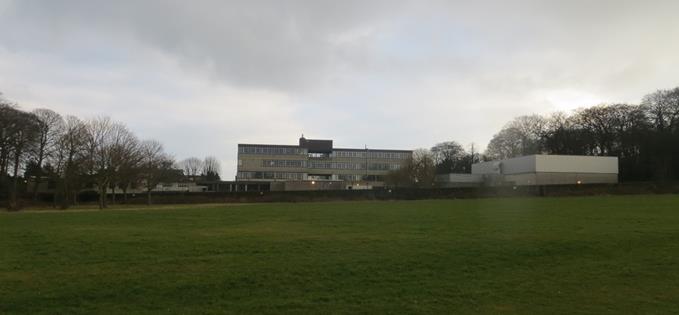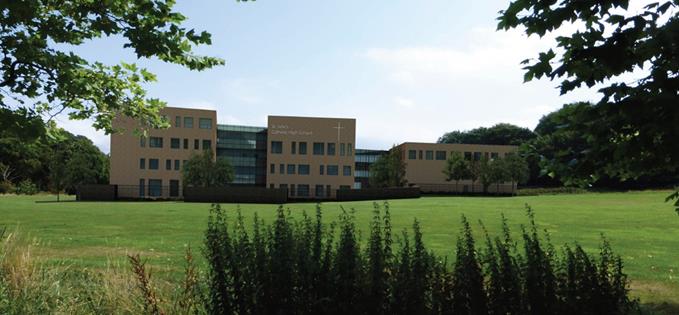A WEDGE of historic Woolton Woods could be lost next week when Liverpool Planning Committee is urged to approve plans for the new St Julie’s Catholic School.
Committee members will make a whistle-stop visit to L25 to see the site for themselves before returning to the Town Hall to debate the application, although refusals are quite rare.
In a 44-page report to the committee, the many objections, raised over the past year by furious villagers, are highlighted.
There are few protests over St Julie’s being re-built, but Woolton Woods, and the loss of part of it, remains the battle ground with even the former landowners, the Reynolds clan, voicing their disapproval.
 The present school
The present school The footprint made by the new school on Woolton Woods land
The footprint made by the new school on Woolton Woods landPlanning officials, who are recommending the scheme be approved, make it clear that a covenant on the land (declaring its use as public open space) is not a planning matter. But for good measure they throw in that the council has taken legal advice and the opinion is a covenant “is not enforceable”.
Given the Mayoral quest to replace schools in Liverpool, it seems unlikely that the scheme can be stopped without a legal challenge or intervention by the new secretary of state for communities, Greg Clarke, who has replaced Sir Eric Pickles in the recent cabinet re-shuffle.
In the report, the head of Planning says he has had regard to all objections, but considers that the replacement school primarily within the confines of the existing site, with some encroachment in to Woolton Woods, would not result in any material harm to the setting of the listed building, other adjacent heritage assets and Woolton Village conservation area.
“There would be no significant loss in amenity to local residents given the relatively small percentage of land to be developed over and there would be no negative impact on linkages between sites and ecology, subject to adherence to mitigating conditions. Highway safety also would not be adversely impacted.”
He concludes: “Whilst there is some loss of green space, this would not fundamentally undermine the ability to use the remainder of Woolton Woods for its existing purposes and therefore the social and health impacts, although evident, would be minimal.”
The alternatives: Rebuilding, Parklands and that Reynolds covenant
 Fit for purpose? The state-of-the-art Parklands school in nearby Speke which closed last year
Fit for purpose? The state-of-the-art Parklands school in nearby Speke which closed last yearRebuilding within the existing St. Julie’s site.
There is insufficient space to rebuild the school on the existing site. The only way would be to completely decant the school off the current school site into temporary accommodation, demolish the school, then build the new school and then decant the school back into the new buildings. This would be cost prohibitive and the school would not accept this major disruption to pupil’s education.
Using the former showpiece school, Parklands in Speke...
...either as an alternative site or in the interim during building. Since the closure announcement last year, the council has been working to identify other users that could move into the buildings. Everton Free School has already taken a large part of the buildings from September 2014 and the council is in discussion with a number of other parties.
Using the Gateacre Comprehensive site.
A preferred developer has already been selected by the council to look at a housing scheme for this site. The future sale of that site would contribute funding towards the wider School Investment Programme. A planning application for housing (200 dwellings) is currently under consideration for this site.
On the covenant following the gift of the Woolton Woods by Col Reynolds in 1921.
What the council says: The covenant restricting its use to the people of Liverpool for recreational purposes in the form of a public park, deeded by covenant by Col James Reynolds, has been raised repeatedly.
A covenant is a legal restriction operating in its own right and therefore the grant of planning permission would not override a covenant. It is not, therefore a material consideration in the determination of the application to be given significant weight.
Notwithstanding this, in the interests of providing (committee) members with a balanced view, the applicants have issued a statement on this matter: “Liverpool Schools Investment Programme Team (Liverpool City Council) have sought legal advice on the position of the covenant on the open space.
The legal opinion is that the covenant, which dates from 1921, is no longer enforceable so there is no question of the council breaking the covenant. It is worth noting the land in question was not gifted to the council. The former corporation paid the not inconsequential (at that time) price of £10,000 for the land. As regards the issue of the Youth Club building (on the site) the council’s position is that the construction of the building would not have been permitted by the covenant if the covenant had been enforceable.”













